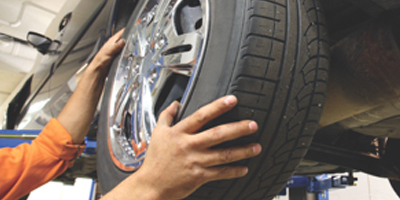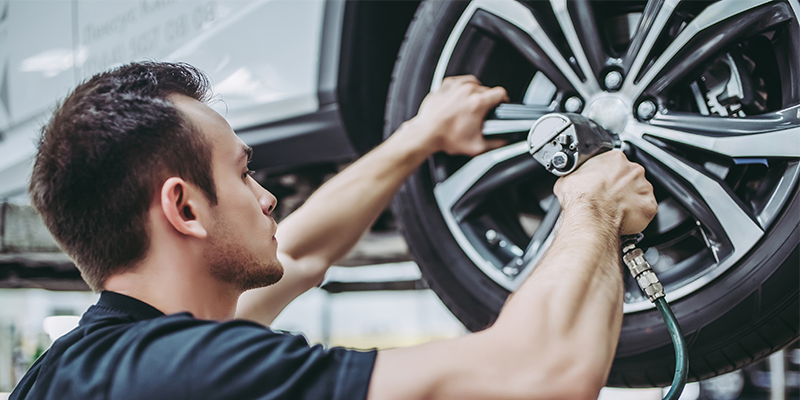This article on how to properly rotate vehicle tires is the third in a series on basic tasks performed in tire shops. Our first in the series covered Basic Tire Repair (February 2012), and the second addressed Tire Demounting and Mounting (May 2012).
This installment reviews the proper tire rotation practices that are recommended for all vehicle types, but concentrates on AWD cars, light trucks and SUVs. It is intended not only for newly trained tire technicians, but also veterans who want to brush up on their techniques.
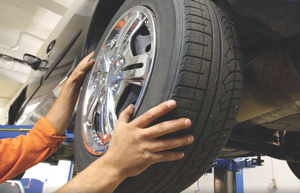
Background information for this article was supplied by Doug Jones, customer engineering support manager for Michelin North America, and from a variety of industry experts and groups.
AWD and its History
It’s generally agreed that the first all-wheel drive production car was the Audi Quattro, which was available in 1976 for rally-car racing. It has spread, thanks to automakers like Subaru, and has become a very common request by today’s drivers who are looking for enhanced driving safety.
AWD is basically a full-time, four-wheel-drive system in which all four wheels receive torque from the engine simultaneously. The purpose is to send power to all four wheels of a vehicle all of the time, creating greater traction and stability in all weather and ground conditions.
The system was developed for people who drive in a lot of different weather conditions and on different types of roads. Because it is a full-time system, AWD is considered to provide better traction, handling and lateral stability. At the same time, understeer may be an issue and handling may be slightly different than front-wheel drive or rear-wheel drive vehicles, but is not considered a major concern. Most drivers can adjust quickly to the difference.
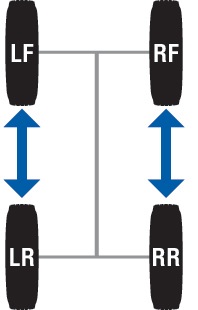
The key to AWD is a center differential that enables each tire to rotate at a different speed based on the tractive needs of any one wheel. Because of this independent rotation, an AWD system eliminates problems such as wheel hop and driveline binding caused by basic 4WD systems when driven on pavement.
Today, there are scores of AWD vehicles that include makes/models such as the Land Rover LR3, Honda CR-V, Jeep Wrangler, BMW X5, Range Rover, Subaru Outback, Toyota 4Runner, Ford Fusion, Acura, Lexus GS 350, Kia Sorento, Volvo S80 T6, Honda Pilot and Lincoln MKX. Because of the growing popularity and consumer demand for AWD, the list could go on almost forever.
Each of these vehicles has its own personality and performance characteristics, but all of them are aimed at operating more safely in bad weather conditions. Some manufacturers have optimized their vehicles for winter driving, and these makes should be considered for driving in more frigid zones. At least one more expensive model has an AWD system that shifts torque to the wheels continuously, including front-to-rear and side-to-side.
Importance of Proper Tire Rotation
Drivers should never try to rotate their own tires; tire rotation is a job for tire technicians who have the proper equipment and experience. Drivers who try to do it themselves run the risk of serious injury, as well as possible damage to the tire and wheel.
Tire rotation is a basic of vehicle preventative maintenance; it is a well-proven fact that tire tread life can be greatly enhanced by regular and timely tire rotation. During rotation, each tire and wheel is removed from a vehicle and moved to a different position to ensure that all tires wear evenly and last longer. Tires should be rotated every six months or 6,000 to 8,000 miles, according to tire experts (TIA says 5,000 to 8,000). The vehicle owner’s manual should be checked for specific rotation recommendations. If no rotation period is specified, tires should be rotated according to the tiremaker’s recommendations.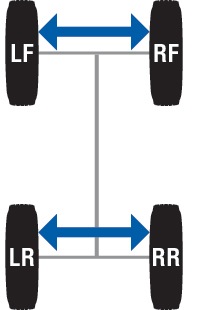
If irregular wear becomes apparent or if the wear rate on the tires is perceptively different (from axle to axle or across an axle), then the tires should be rotated in such a manner as to try to alleviate the condition. If done early enough, rotation can arrest or prevent the onset and/or progression of irregular wear.
It is very important to understand the causes of the irregular or rapid wear prior to rotating the tires.
First, each tire supports a different amount of weight due to the design of the vehicle. This unequal weight distribution causes each tire to wear at a different rate. Driving style – particularly aggressive driving – also can contribute to premature and irregular wear.
If the problem is alignment-related or mechanical-related, it should be corrected during the process of rotation. If wear concerns are driver-related, suggest to the owner that he can save himself wear-and-tear on his vehicle and pocketbook by toning it down.
Also, make sure you have the right tire for the application; some tires simply don’t work in certain situations.
Proper Tire Rotation
There have been many articles and statements made online and in other media cautioning against trying to rotate tires on an AWD vehicle. In fact, with the exception of directional-tread tires, there is no barrier to performing a proper tire rotation on most makes/models of AWD vehicles.
In order to understand fully the rationale for maintenance on tires mounted on an AWD vehicle, it helps to review rotation practices on vehicles with other drive types. The general rule for tire rotation is to cross the free-rolling axle.
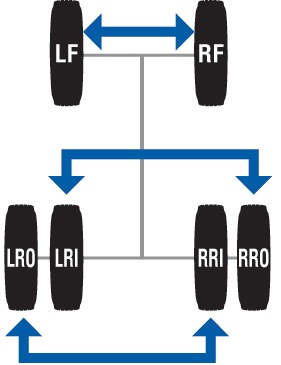
4×2
In a 4×2 application, the tires on the drive axle will wear faster and the tires on the non-drive axle will be more susceptible to irregular wear. The best rotation is front-to-back – moving the tire from the non-driven axle to the driven axle – to even out the wear, according to Michelin.
TIA recommends, however, that on a FWD vehicle, the front tires are rotated straight back to the rear and the rear tires are crossed to the front. The opposite is true for a rear-wheel-drive vehicle, according to TIA, so the front tires should be crossed to the back while the rear tires are rotated straight to the front.
Light Truck (4×2)
If the vehicle has “all-position tires” with the same tread on all wheel positions and no retreads, and with single (instead of dual) tires on the drive axle, then the rotation pattern is simple – use the traditional X pattern.
If the vehicle has a designated “steer” tire on front and drive tires or drive tire retreads on rear – the side-to-side rotation pattern is preferred. Rotate left front to right front, left rear to right rear.
Light Truck (4×2 with duals on drive axle)
If the light truck has duals on the rear drive axle, then the fronts should be rotated side-to-side and the drives from side-to-side. However, the inside dual should be moved to the outside dual position on the opposite side of the vehicle.
Medium Duty (6×4)
With this type of vehicle, the steer axle tires should be rotated side-to-side. The drive tires should be rotated from the second axle to the third axle in an X pattern on both sides. The left outer tire on the second axle (2LO) will be moved to the third axle inner (3LI) position, and the 2LI tire will be moved to the 3LO position; the same pattern is repeated on the other side. The key is to get the tires to a different axle and/or wheel position, if possible.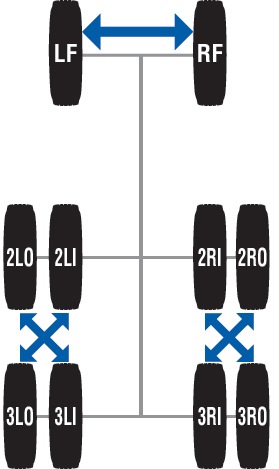
What About Directional Tires?
Directional tires are particularly designed to channel water from the center of a tire outward as the tire rotates. They have grooves in the tread that form a V-shaped pattern. This construction and tread is designed to rotate in only one direction.
These tires usually have an arrow with the word “Rotation” on the sidewall, showing the proper rotation direction. To rotate directional tires, just switch the front and rear tires on each side – right front to right rear, and left front to left rear.
Tire Rotation on an AWD Vehicle
In AWD or 4×4, the X pattern is usually the preferred pattern (See diagram.) The front right tire is moved to the left rear position, and the front left tire is moved to the right rear position and vice versa.
Before rotating the tires, a number of items should be checked. These include:
• Make sure the tires have uniform tread depths, particularly across an axle. The customer should be told that if the difference in tread depth between the front and rear tires is more than 2/32 of an inch, the tires with the deepest tread should be placed on the rear axle.
• Check to ensure the tires are inflated to the proper inflation level recommended by the vehicle manufacturer.
• Inspect to ensure the tires are the same size, same tread pattern and same brand.
• Never mix tire sizes, and never mix tire types (winter, summer, all-season).
• Never mix radial and bias ply tires on the same vehicle.
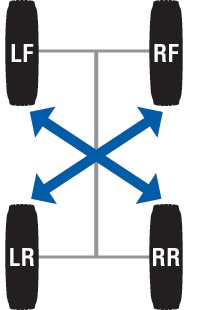
Full Size Spares
The X pattern recommended previously is for a four-tire rotation pattern. But what if you want to include a full-sized spare in the rotation? It is recommended that you include it in the rotation by placing it on the rear with a tire that is closely matched in tread depth. The most worn tire should be removed and utilized as a spare. You want the four best tires – that is, the least worn – on the ground.
This is a rare rotation procedure since many vehicles feature temporary spare tires. Even with some that still feature full-size spares, owners discover they are mounted on steel wheels that do not match the aluminum alloy wheels on the vehicle.
An even newer dilemma is smaller sized full-size spares. You may have a vehicle that takes 16-inch wheels and find out the full-size spare is on a 15-inch wheel. These so-called “full-size spares” are intended for temporary use and are usually mounted on generic steel wheels.
Integrating the full-size spare in a five-wheel rotation can be done a couple of ways. A forward cross as used on FWD vehicles drops the passenger-side front tire as the new spare; the old spare would move to the passenger-side rear position and then the two rear tires would crisscross forward.
The rearward cross rotation for 4WD, RWD and AWD drops the driver’s side front tire as the new spare. The old spare still moves to the passenger rear position and then the passenger front tire moves to the driver’s side rear. The rear tires would move straight forward to the front axle position.
Many technicians inquire about replacing just one or two tires on an AWD vehicle with the remaining tires. It is highly recommended to replace them two at a time and always put them on the rear axle.
AWD vs. 4WD
Q: Should different types of tires than those used for 2WD and 4WD be mounted on AWD vehicles? If so, what is the difference in these tires?
A: Most passenger tires are all-wheel position tires, so they can be mounted on 2WD as well as 4WD. Some drivers may prefer a more aggressive tread pattern on AWD vehicles if they are planning to do some off-road driving or driving in mud or snow.
Q: Do tires wear faster on an AWD vehicle?
A: Yes, they do, because of the torque applied by the AWD.
Q: What’s the difference between 4WD and AWD drivetrains?
A: There are so many different types of AWD and 4WD systems that it is difficult to describe one main difference. Originally, AWD required no changing of one mode to another and was only on cars. Today, AWD has spread to SUVs and CUVs, as well as minivans. 4WD allows the driver to shift between 2WD and 4WD, and is typically on pick-up trucks; there may be low- and high-gear range options.
Some SUVs are sold as 4WD when in reality they are AWD. For simplicity’s sake today, on AWDs, all wheel positions are driven all the time. 4WD vehicles usually allow the driver to manually select between 2WD and 4WD (part-time) or the vehicle shifts between the different drives based on the road surface or conditions.
Q: Are AWD and 4WD vehicles intended for different uses?
A: In general, yes. AWD is intended for on-road driving with various weather conditions that may affect driving, including rain, snow and mud. 4WD is primarily for off-road driving and/or extreme weather conditions.
Q: Can AWD be used on dry pavement?
A: Yes, it can and usually is. By comparison, part-time 4WD must be shifted and doesn’t operate as well on dry pavement.
Q: Is it important to make sure tires are matched on AWD vehicles as well as 4WD vehicles?
A: Yes, particularly across an axle, because unmatched tires strain a vehicle’s driveline.
Q: Should drivers make sure that the tires on their AWD vehicles have uniform tread depths?
A: Again, yes, across an axle.
The Bottom Line
Tire rotation is an essential part of tire maintenance on all vehicles, and therefore is a key component of your customer service arsenal. It is even more important on AWD vehicles because the full-time, all-wheel drive system wears tires faster than other vehicle types.
For this reason, it is important that tires on an AWD vehicle are of the same size/diameter, tread design, brand, inflation pressure and tread depth. Varying from this regimen can cause components in the AWD driveline to be damaged and eventually fail.
AWD Rotation Checklist
The main steps in the AWD tire rotation procedure are as follows:
- Visual inspection to include tread depth measurement and checking for tire damage and unusual wear patterns that could be caused by a mechanical problem.
- Check the vehicles owner’s manual or tire manufacturer’s recommendation to note the recommended tread depth. Note: If a wear indicator is even with the rib or block on either side, this indicates that the tread has less than 2/32-inch in depth and the tire should be taken out of service.
- Remove the tire/wheel assemblies.
- Correct any problems with the tire and wheel assembly when it has been removed.
- Rotate the tires using the X pattern noted in the previous section on AWD tires. Use the variations noted above when adding a spare to the rotation.
- Check tires for the proper inflation pressure, following the psi recommended in the vehicle owner’s manual or by the tire manufacturer.
Disclaimer
Tire rotation is a serious business. The preceding article was researched and written using material furnished by Michelin North America and other industry sources. This information is not meant as a substitute for proper training by TIA or the tire manufacturers. The rotation pattern illustrations were supplied by Michelin. The rotation recommendations made here are consistent with practices used in the industry. This article is meant purely for educational purposes and those who use the methods recommended are solely responsible for any injuries or losses resulting from their application.

